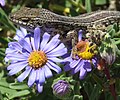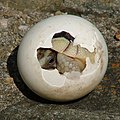Introduction
Selected reptile type
Amphisbaenia /æmfɪsˈbiːniə/ (called amphisbaenians or worm lizards) is a group of typically legless lizards, comprising over 200 extant species. Amphisbaenians are characterized by their long bodies, the reduction or loss of the limbs, and rudimentary eyes. As many species have a pink body and scales arranged in rings, they have a superficial resemblance to earthworms. While the genus Bipes retains forelimbs, all other genera are limbless. Phylogenetic studies suggest that they are nested within Lacertoidea, closely related to the lizard family Lacertidae. Amphisbaenians are widely distributed, occurring in North America, Europe, Africa, South America, Western Asia and the Caribbean. Most species are less than 6 inches (15 cm) long. (Full article...)
Selected Crocodilia article

The black caiman (Melanosuchus niger) is a crocodilian reptile endemic to South America. With a maximum length of around 5 to 6 m (16 to 20 ft) and a mass of over 450 kg (1,000 lb), it is the largest living species of the family Alligatoridae, and the third-largest crocodilian in the Neotropical realm. True to its common and scientific names, the black caiman has a dark greenish-black coloration as an adult. In some individuals, the pigmentation can appear almost jet-black. It has grey to brown banding on the lower jaw; juveniles have a more vibrant coloration compared to adults, with prominent white-pale yellow banding on the flanks that remains present well into adulthood (more than most other species). The banding on young animals helps with camouflage by breaking up their body outline, on land or in water, in an effort to avoid predation. The morphology is quite different from other caimans but the bony ridge that occurs in other caimans is present. The head is large and heavy, an advantage in catching larger prey. Like all crocodilians, caimans are long, squat creatures, with big jaws, long tails and short legs. They have thick, scaled skin, and their eyes and noses are located on the tops of their heads. This enables them to see and breathe while the rest of their bodies are underwater.
A carnivorous animal, the black caiman lives along freshwater habitats, including slow-moving rivers, lakes and seasonally flooded savannas, where it preys upon a variety of fish, reptiles, birds, and mammals. Being an apex predator and potentially a keystone species, it is generalist, capable of taking most animals within its range, and might have played a critical role in maintaining structure of the ecosystem. Although merely few specific ecological studies have been conducted, it is observed that this species has its own niche which allows coexistence with other competitors.
Reproduction takes place in the dry season. Females build a nest mound with an egg chamber, protecting the eggs from predators. Hatchlings form groups called pods, guarded by the presence of the female. These pods may contain individuals from other nests. Once common, it was hunted to near extinction primarily for its commercially valuable hide. It is now making a comeback, listed as Conservation Dependent. Overall a little-known species, it was not researched in any detail until the 1980s, when the leather-trade had already taken its toll. It is a dangerous species to humans, and attacks have occurred in the past. (Full article...)
Selected lizard article
The Fiji crested iguana or Fijian crested iguana (Brachylophus vitiensis) is a critically endangered species of iguana native to some of the northwestern islands of the Fijiian archipelago, where it is found in dry forest on Yaduataba (west of Vanua Levu), Yadua, Macuata, Yaquaga, Devuilau (Goat island), Malolo, Monu and Monuriki. (Full article...)
Selected turtle article
The striped mud turtle (Kinosternon baurii) is a species of turtle in the family Kinosternidae. The species is native to the southeastern United States. (Full article...)
Picture slideshow
Selected snake article

The dwarf beaked snake (Dipsina multimaculata), also called the western beaked snake, is a species of snake, which is endemic to southern Africa. It is in the monotypic genus Dipsina. (Full article...)
Categories
Topics
Associated Wikimedia
The following Wikimedia Foundation sister projects provide more on this subject:
-
Commons
Free media repository -
Wikibooks
Free textbooks and manuals -
Wikidata
Free knowledge base -
Wikinews
Free-content news -
Wikiquote
Collection of quotations -
Wikisource
Free-content library -
Wikiversity
Free learning tools -
Wiktionary
Dictionary and thesaurus































































